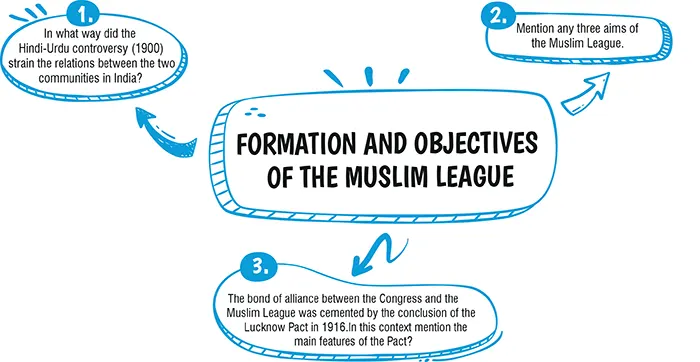Home / Board / ICSE / important Questions / Class 10 / History & Civics / Formation and Objectives of the Muslim League
Table of Contents

Ans. (b) Sultan Muhammad Shah (Aga Khan III)
Explanation:
The first annual session of the Muslim League took place in Karachi on December 29, 1907, with Sir Sultan Mohammed Shah, the Aga Khan III, serving as the first Honorary President. The headquarters of the Muslim League were located in Lucknow.
Ans. (d) Separate electorate for Muslims
Explanation:
The deputation presented a memorial to the Viceroy, which included demands for the following: the granting of separate electorates for Muslims, an allocation of three additional seats for Muslims in the central legislature, and the establishment of a quota for Muslims in the civil services.
Explanation:
Urdu was the court language in Uttar Pradesh. The Hindu community protested and demanded that they should be allowed to submit petitions in Hindi in Devanagari script. The Government granted this request. Thus, the Hindi-Urdu controversy further strained the relations between the Hindus and Muslims.
Explanation:
The aims of the League were laid down as follows :
(i) To promote among Indian Muslims, feelings for loyalty towards the British Government. The League would also remove misconceptions regarding the intentions of the Government towards Indian Muslims.
(ii) To protect the political and other rights of the Muslims and to place their needs and aspirations before the Government in mild and moderate language.
(iii) To prevent the rise of any feeling of hostility between Muslims and other communities, without adversely affecting the aforesaid objectives of the League.
Explanation:
i) Independent Unit : India was to be treated as an independent unit of the Empire, as a self autonomous state with equal rights and responsibility.
(ii) Provincial Legislatures : Four-fifth of the members of the Provincial Legislatures were to be elected and one-fifth nominated. One-third of the elected members were to be Muslims.
(iii) Powers of the Imperial Legislative : Defence, foreign affairs and political relations of India i.e., making of war, peace and signing of treaties were to be excluded from the control of the Imperial Legislative.
(iv) Bills related to Religious Interests : No bill could be introduced in the Legislative Council if it affected the interest of any community and such a bill could not be passed if it was opposed by three-fourths of that community.
(v) Composition of Viceroy’s Executive Council : Half the members of the Viceroy’s Executive Council should be Indians elected by the elected members of the Imperial Legislative Council.
(vi) Separation of Judiciary from Executive : Judiciary should be separated from Executive. Members of the judiciary in every Province should be placed under the control of the highest court of that Province.
(viii) Abolition of Council of the Secretary of State : The Council of the Secretary of State for India shall be abolished and he shall have the same position with regard to the Government of India as he does in relation to the government of self-governing colonies.
Download Mind Map of this chapter
Download NowWant to Practice Mock Tests of this chapter
Practice NowDownload Important Questions of this chapter
Download NowCBSE Important Questions Class 10
ICSE Important Questions Class 10
CBSE Important Questions Class 10
ICSE Important Questions Class 10